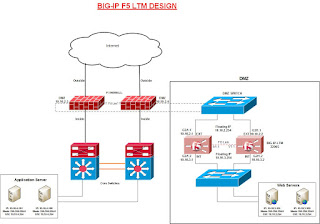--> Self IP Address is the IP Address in F5 which is assigned to VLAN.
--> In Cisco terms, it is similar to SVI where we assign IP Address to VLAN.
--> In F5 LTM, we can assign an IP address to a VLAN or group of VLAN.
--> A static self IP address is an IP address that the BIG-IP system does not share with another BIG-IP system.
--> For each self IP address that you create for a VLAN, the BIG-IP system automatically assigns a media access control (MAC) address.
--> Self IP Address in F5 LTM is used mainly for three purposes,
i) F5 compares destination server IP address with VLAN self IP address to identify which VLAN it belongs to.
ii) Self IP Address can also be used as the Default gateway for the servers if we configure F5 in Inline Mode.
iii) Self IP Address is also used to send monitor probes to the group of servers in that VLAN.
--> There are two types of Self IP Addresses used by F5,
i) Static Self IP Address: This is the IP Address is assigned only to one F5 LTM device.
ii) Floating Self IP Address: This is the IP Address is assigned to multiple F5 LTM devices.
--> In Cisco terms, Floating IP Address is similar to Virtual IP Address which is used for Gateway Redundancy.
--> Floating Self IP Address is used for configuration synchronization between F5 LTM.
--> For Every VLAN in F5 LTM, you need to create both Self IP Address and Floating Self IP Address.
--> Each self IP address has a feature known as the port lockdown. Port lockdown is a security feature that allows you to specify particular UDP and TCP protocols and services from which the self IP address can accept traffic.
Md.Kareemoddin ( CCIE # 54759)
--> In Cisco terms, it is similar to SVI where we assign IP Address to VLAN.
--> In F5 LTM, we can assign an IP address to a VLAN or group of VLAN.
--> A static self IP address is an IP address that the BIG-IP system does not share with another BIG-IP system.
--> For each self IP address that you create for a VLAN, the BIG-IP system automatically assigns a media access control (MAC) address.
--> Self IP Address in F5 LTM is used mainly for three purposes,
i) F5 compares destination server IP address with VLAN self IP address to identify which VLAN it belongs to.
ii) Self IP Address can also be used as the Default gateway for the servers if we configure F5 in Inline Mode.
iii) Self IP Address is also used to send monitor probes to the group of servers in that VLAN.
--> There are two types of Self IP Addresses used by F5,
i) Static Self IP Address: This is the IP Address is assigned only to one F5 LTM device.
ii) Floating Self IP Address: This is the IP Address is assigned to multiple F5 LTM devices.
--> In Cisco terms, Floating IP Address is similar to Virtual IP Address which is used for Gateway Redundancy.
--> Floating Self IP Address is used for configuration synchronization between F5 LTM.
--> For Every VLAN in F5 LTM, you need to create both Self IP Address and Floating Self IP Address.
--> Each self IP address has a feature known as the port lockdown. Port lockdown is a security feature that allows you to specify particular UDP and TCP protocols and services from which the self IP address can accept traffic.
Md.Kareemoddin ( CCIE # 54759)








0 Comments